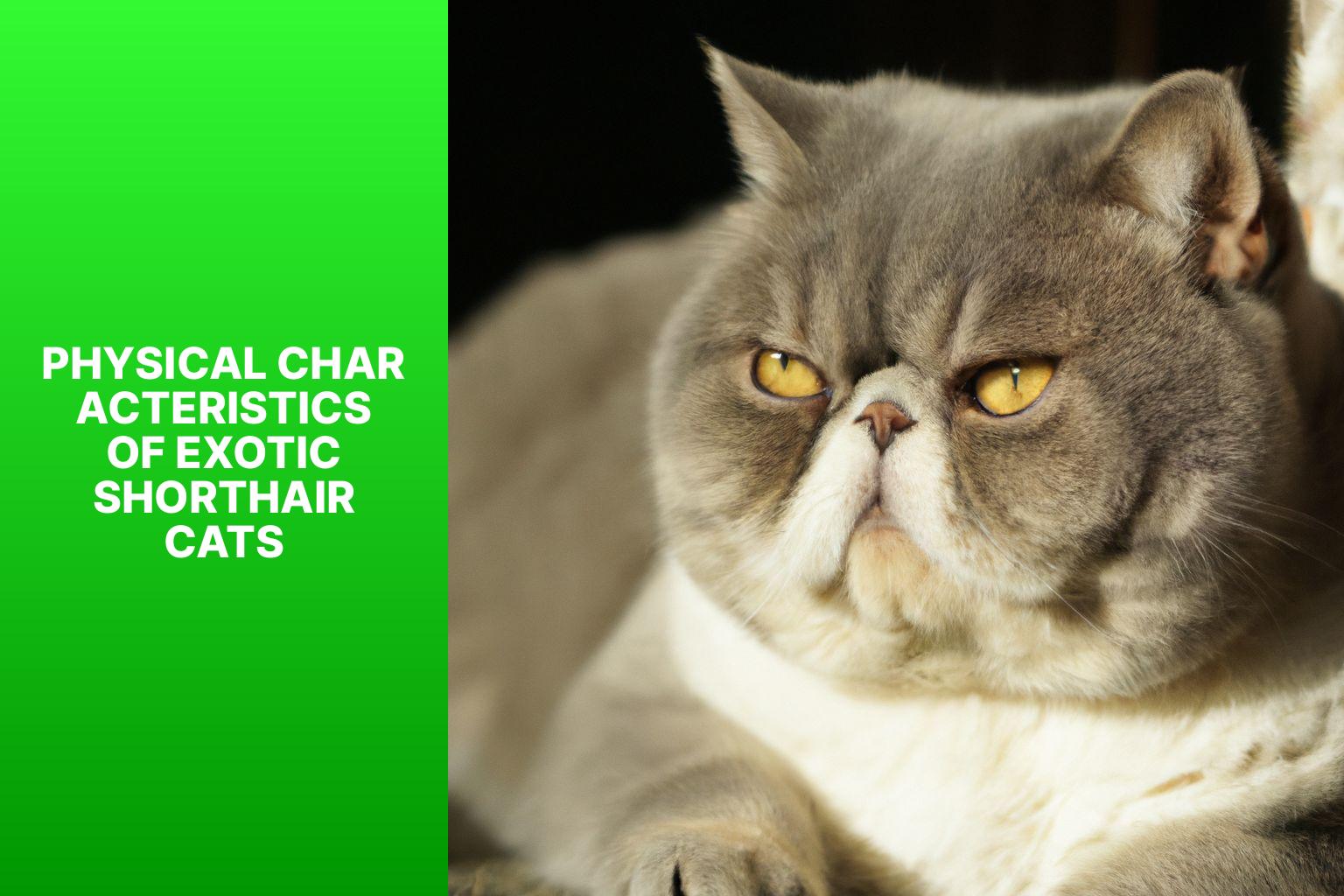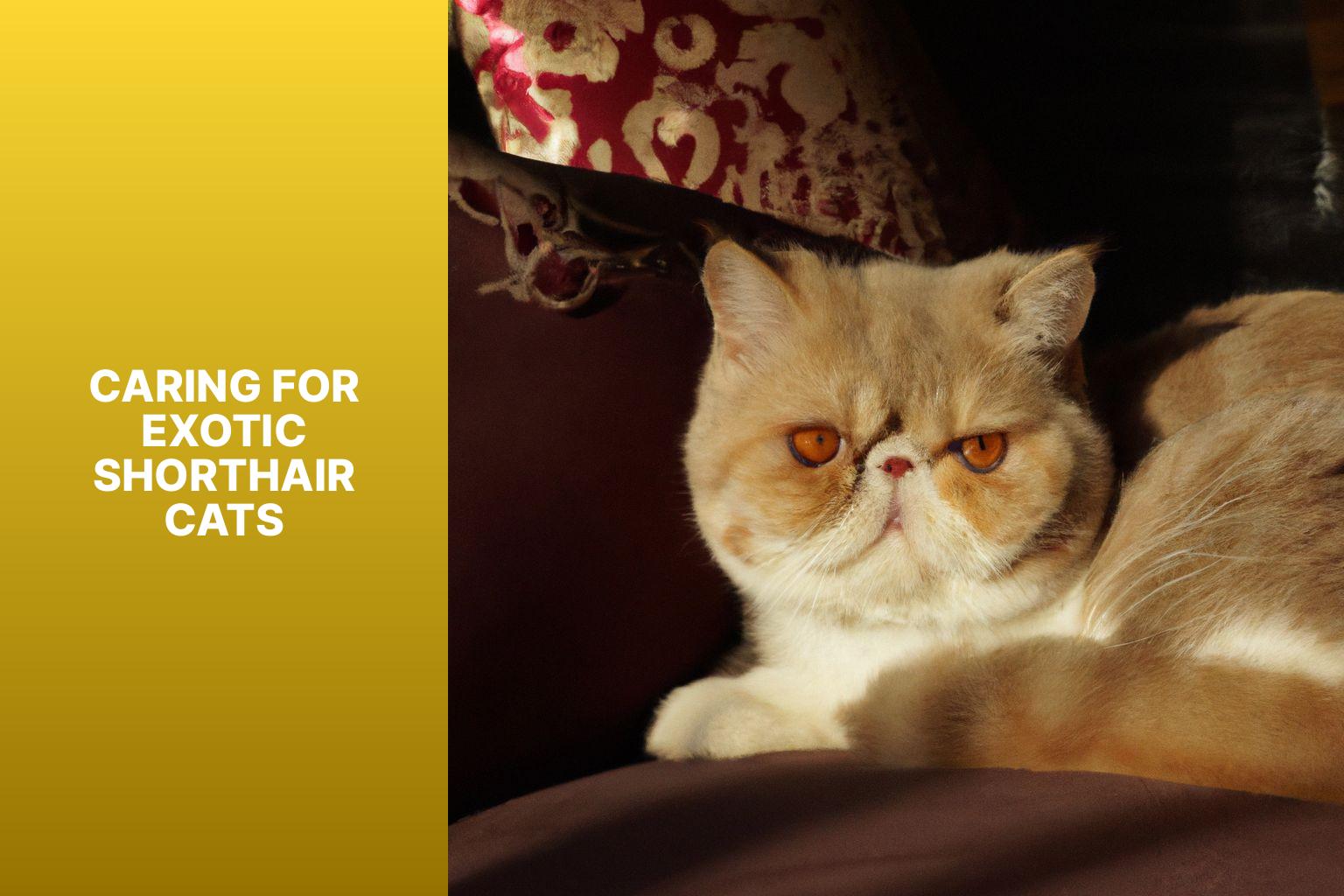Exotic Shorthair cats are a fascinating breed known for their unique appearance and gentle nature. Originating from the crossbreeding of Persian cats with other breeds, these feline companions have gained popularity for their distinctive physical characteristics and endearing personalities. Here is an overview of what makes exotic shorthair cats special.
Origin and History of Exotic Shorthair Cats
Exotic Shorthair cats were created by crossing Persian cats with breeds such as the British Shorthair, American Shorthair, and Russian Blue. This breeding program aimed to retain the Persian’s charming features while introducing a shorter and more manageable coat. Exotic Shorthair cats were first recognized as a breed in the 1960s, gaining popularity rapidly due to their adorable appearance and easy-to-care-for coats.
Physical Characteristics of Exotic Shorthair Cats
While closely resembling Persians, Exotic Shorthair cats have some distinct qualities. Their most notable difference is their dense and plush short coat, which requires less grooming compared to their long-haired relatives. Exotic Shorthairs also have a stockier build, round faces, and large, expressive eyes. Their coat colors and patterns vary widely, offering a wide array of options to choose from.
Temperament and Personality Traits of Exotic Shorthair Cats
These cats are known for their gentle and calm nature, making them ideal companions for individuals or families. They are social and affectionate, enjoying the company of their human family members. While they may be reserved around strangers, Exotic Shorthair cats develop strong bonds with their owners. They are generally easygoing and adapt well to various living situations.
Caring for Exotic Shorthair Cats
Exotic Shorthair cats have specific care needs that contribute to their overall well-being. Their dense coats require regular but less-intensive grooming compared to their Persian ancestors. A balanced diet, specifically formulated for their needs, is essential to maintain their health. These cats also benefit from interactive playtime and mental stimulation to keep them physically and mentally engaged. While Exotic Shorthair cats are generally healthy, they may be prone to certain health issues that require regular veterinary care.
Understanding the origins, physical characteristics, temperament, and care requirements of Exotic Shorthair cats can help potential owners make an informed decision about welcoming these delightful feline companions into their homes.
Key takeaway:
- Exotic Shorthair Cats have a unique origin: They were created by crossing different breeds to achieve their distinctive characteristics.
- Exotic Shorthair Cats stand out with their physical attributes: They have a different coat and facial features compared to Persian Cats.
- Exotic Shorthair Cats require specific care: Grooming, diet, exercise, and medical attention should be tailored to their needs to ensure their well-being.
Origin and History of Exotic Shorthair Cats
The origin and history of Exotic Shorthair cats can be traced back to the 1950s in the United States. This breed was created by crossing Persian cats with American Shorthairs to produce a cat that looks like a Persian but has a shorter coat. The goal was to create a cat with the same cute round face and friendly personality as the Persian, but with less grooming needs.
During breeding, breeders focused on selecting cats with specific traits, such as a short, dense coat and a round head with large, expressive eyes. The breed quickly became popular because it resembled the Persian but required less grooming.
The Exotic Shorthair was officially recognized as a breed by cat associations in the 1960s. Since then, it has remained popular among cat lovers worldwide. Its friendly and affectionate nature, combined with its distinctive appearance, has made it a sought-after companion pet.
Today, Exotic Shorthair cats come in various colors and patterns, including tabby, tortoiseshell, and solid colors. They are known for being friendly and laid-back, making them great family pets or companions for people of all ages. The breed’s popularity continues to grow, and it is now recognized and loved by cat enthusiasts worldwide.
What Breeds Were Crossed to Create Exotic Shorthair Cats?
Exotic Shorthair cats were created by carefully selecting and crossing specific breeds to achieve their unique characteristics and appearance. In order to develop this breed, Persians were crossed with shorthaired breeds to create a cat that had the distinctive features of a Persian but with a shorter coat. Additionally, American Shorthairs were crossed with Persians to introduce the shorthair gene, resulting in cats with a dense and plush coat similar to the Persian but shorter. The inclusion of Burmese cats also played a role, contributing to the coat texture and body shape of the Exotic Shorthair. The combination of these three breeds, Persian, American Shorthair, and Burmese, led to the development of the Exotic Shorthair breed.
The ultimate goal of this breeding program was to maintain the desirable features of the Persian, such as the round face, distinct expression, short muzzle, and wide-set ears, while offering a lower-maintenance coat. As a result, Exotic Shorthair cats are popular pets known for their charming and adorable appearance.
When Were Exotic Shorthair Cats First Recognized as a Breed?
Exotic Shorthair cats were officially recognized as a breed by the Cat Fanciers’ Association (CFA) in 1966 when breeders crossed Persian cats with American Shorthairs. This recognition allowed them to participate in cat shows and showcase their unique features. Originally created to mimic the Persian’s appearance while requiring less grooming, Exotic Shorthair cats quickly became popular for their distinct characteristics such as a round face, short muzzle, wide-set ears, and compact body. Since their first recognition, these felines have steadily grown in popularity, making them a sought-after choice for individuals desiring an extraordinary and easy-to-care-for pet.
Physical Characteristics of Exotic Shorthair Cats
Photo Credits: Www.Catcornerblog.Com by Jeremy Allen
The physical characteristics of Exotic Shorthair cats are distinct and unique. Exotic Shorthairs have a sturdy, muscular body with a short, thick neck. They have a large, round head with prominent cheeks and a short nose. Their eyes are large, round, and expressive. The small, rounded ears are set wide apart on the head. Exotic Shorthairs have a dense, plush coat that is short and soft to the touch. They come in a wide range of colors and patterns, including solid, tabby, tortoiseshell, and colorpoint. Their tail is short and thick, in proportion to their body. Exotic Shorthairs are medium-sized cats with a solid, compact build. These cats have a calm and gentle temperament, making them excellent cuddle buddies.
What Makes Exotic Shorthair Cats Different from Persian Cats?
Exotic Shorthair cats and Persian cats have several differences that set them apart. One notable distinction is their facial structure. Unlike Persian cats, Exotic Shorthair cats have a round face and a short muzzle, giving them a distinct expression.
Another difference lies in their coats. While Persian cats have long and luxurious coats that require extensive grooming, Exotic Shorthair cats have shorter coats that are easier to maintain.
Their body types vary. Exotic Shorthair cats have a compact and muscular body, whereas Persian cats have a more delicate and slender build. The ears of these two breeds also differ. Exotic Shorthair cats have wider-set ears, which further highlight their round faces, while Persian cats have smaller and closer-set ears.
In terms of temperament, both breeds share a calm and gentle nature. However, Exotic Shorthair cats tend to be more playful and outgoing compared to Persian cats.
All these distinctions in facial structure, coat length, body type, ears, and temperament contribute to the uniqueness of Exotic Shorthair cats in comparison to Persian cats. Whether you prefer the distinctive round face and shorter coat of the Exotic Shorthair or the elegant and flowing coat of the Persian, both breeds possess their own special charm.
Coat Colors and Patterns of Exotic Shorthair Cats
| Coat Colors | Patterns |
| White | Solid |
| Black | Tabby |
| Blue | Tortoiseshell |
| Red | Bicolor |
| Cream | Calico |
| Chocolate | Smoke |
| Lilac | Pointed |
| Cinnamon | Patched tabby |
Exotic Shorthair cats have a variety of coat colors and patterns. Common coat colors include white, black, blue, red, cream, chocolate, lilac, and cinnamon. These cats can have patterns such as solid, tabby, tortoiseshell, bicolor, calico, smoke, pointed, and patched tabby. The coat colors and patterns contribute to the unique appearance of Exotic Shorthair cats.
One story that showcases the beautiful coat colors and patterns of Exotic Shorthair cats involves a rescue named Luna. Luna was found abandoned and brought to a shelter. With her stunning tortoiseshell coat, she caught the attention of a family looking to adopt a cat. They fell in love with her unique markings and brought her home. Luna quickly became a beloved member of the family, bringing joy and happiness to everyone. Her coat colors and patterns not only made her visually appealing but also added to her unique personality. Luna’s story is just one example of the beauty and individuality found in the coat colors and patterns of Exotic Shorthair cats.
Distinctive Facial Features of Exotic Shorthair Cats
The distinctive facial features of exotic shorthair cats include a round face, short muzzle, and wide-set ears. These distinctive facial features set them apart from other breeds of cats. The round face gives them a unique expression that cat lovers find irresistible. Their short muzzle adds to their distinct appearance. The wide-set ears enhance their overall appeal and make them even more adorable. These distinct facial features contribute to the cute and charming look of exotic shorthair cats, which is why they are a popular choice among cat lovers.
Temperament and Personality Traits of Exotic Shorthair Cats
Temperament and Personality Traits of Exotic Shorthair Cats
Exotic Shorthair cats have a lovable and affectionate temperament.
– Sweet and Gentle: These cats have a sweet and gentle demeanor, making them great companions for families and individuals.
– Calm and Relaxed: Exotic Shorthairs are known for their calm and relaxed nature. They enjoy a peaceful environment and are not demanding.
– Sociable and Friendly: These cats love human company and get along well with children and other pets. They enjoy being part of the family.
– Playful and Curious: Despite their relaxed nature, Exotic Shorthairs still have a playful side. They enjoy interactive playtime and exploring.
– Lap Cats: Exotic Shorthairs love cuddling and being lap cats. They enjoy snuggling up and are sought after for their affectionate nature.
If you’re considering getting an Exotic Shorthair cat, provide them with a calm and loving environment. Spend quality time with them and engage in interactive play. Their gentle and sociable nature ensures rewarding companionship.
Are Exotic Shorthair Cats Social and Affectionate?
Exotic Shorthair cats are incredibly social and affectionate creatures! They truly enjoy the company of their human companions and are known to continually seek out attention.
One of their most endearing qualities is their ability to form strong bonds with their owners, sometimes even becoming a tad clingy. These cats are so dedicated that they will personally greet you at the door and faithfully follow you around the house.
They are incredibly friendly and loving towards their family members, which makes them an excellent addition to any household, especially those with children. In fact, Exotic Shorthair cats are exceptional with kids, making them the perfect choice for families.
They are quite sociable and love having the company of other pets, including dogs and cats. When introducing new pets, it’s essential to do so gradually and closely supervise their interactions.
Exotic Shorthair cats may take a little time to adjust to new environments or changes in routine, but rest assured, they usually adapt quite well and remain just as friendly and affectionate as ever!
Do Exotic Shorthair Cats Get Along with Other Pets?
Exotic Shorthair cats, also known as Persian Shorthair cats, are renowned for their ability to coexist harmoniously with other pets. When evaluating the compatibility between Exotic Shorthairs and other animals, several factors should be taken into account. These include socialization, personality, introductions, and overall compatibility with different types of pets.
To foster good relationships with other pets, it is crucial to ensure proper socialization and expose Exotic Shorthair cats to various animals. This exposure helps them feel at ease in the presence of other pets. Known for their friendly and easygoing nature, Exotic Shorthairs are generally less territorial and more accepting of other animals. They possess an innate ability to adapt to different companions.
Gradual introductions of new pets in a controlled environment can greatly enhance the likelihood of a successful and harmonious relationship. By monitoring their interactions and reactions, owners can assess compatibility and make informed decisions about the suitability of the pets cohabitating.
Caring for Exotic Shorthair Cats
Photo Credits: Www.Catcornerblog.Com by Raymond Jackson
Caring for Exotic Shorthair Cats
When caring for exotic shorthair cats, follow these guidelines:
- Provide a balanced diet: Exotic shorthair cats need a balanced diet for their health. Consult with a veterinarian for the right type and amount of food.
- Groom regularly: Regular grooming is essential for the well-being of an exotic shorthair cat. Brush their coat to prevent matting and remove loose hair. Pay special attention to their face and eyes, as tear stains can occur.
- Maintain dental hygiene: Exotic shorthair cats are prone to dental issues. Establish a dental care routine by regularly brushing their teeth with cat-friendly toothpaste. Provide dental treats or toys for clean teeth.
- Provide mental stimulation: Exotic shorthair cats are intelligent and need mental stimulation to avoid boredom. Engage them in interactive play with toys and provide scratching posts or climbing towers for entertainment.
- Schedule regular veterinary check-ups: Monitor your exotic shorthair cat’s health with regular veterinary check-ups. This includes vaccinations, parasite prevention, and overall health assessment for their well-being.
- Create a safe environment: Exotic shorthair cats are playful, so ensure a safe home. Remove harmful plants, secure windows and balconies, and keep toxic substances out of their reach.
Following these guidelines will ensure a happy and healthy life for your exotic shorthair cat.
What Are the Grooming Needs of Exotic Shorthair Cats?
Exotic Shorthair cats have specific grooming needs. So, what are the grooming needs of Exotic Shorthair cats? Here are some important tasks to keep in mind:
1. Brush their coat regularly: Exotic Shorthair cats have a dense and thick coat. Regular brushing is essential to prevent matting and maintain a healthy and shiny coat.
2. Clean their ears: Exotic Shorthair cats have wide-set ears that are prone to wax and debris buildup. To prevent infections, it is important to gently clean their ears with a veterinarian-approved ear cleaner.
3. Trim their nails: To prevent discomfort, Exotic Shorthairs need regular nail trims. Be sure to use a cat-specific nail clipper and carefully trim their nails.
4. Monitor their eyes: Keep an eye on their eyes for any discharge or signs of irritation. If needed, you can gently clean their eyes with a damp cloth.
5. Give them regular baths: Occasional baths are beneficial for Exotic Shorthair cats to keep their fur clean and free from oils. Remember to use a cat-specific shampoo and follow instructions carefully.
Remember, each cat is unique, so their grooming needs may vary. Pay close attention to your Exotic Shorthair cat’s coat and grooming habits to determine the frequency and specific requirements for grooming.
Now you know the grooming needs of Exotic Shorthair cats. These cats were developed in the 1950s through a breeding program that combined Persian cats with American Shorthair cats. The goal was to create a breed with the desirable appearance of Persians, such as a round face and short muzzle, but with a shorter and more manageable coat. Today, Exotic Shorthair cats are beloved companions and show cats worldwide. They are recognized as a distinct breed by cat registries and cherished for their affectionate nature and adorable looks.
What Type of Diet Is Suitable for Exotic Shorthair Cats?
To address the question of what diet is appropriate for Exotic Shorthair cats, consider the following table:
| Diet Type | Description | % Daily Requirement |
| High-Quality Protein | Exotic Shorthair cats need protein from sources like chicken, turkey, or fish for growth, muscle development, and a healthy coat. | 30%-40% of daily calories should come from protein. |
| Fiber | To maintain a healthy digestive system and prevent constipation, include fiber from vegetables or grains in their diet. | Around 10%-15% of daily calories should come from fiber. |
| Essential Fatty Acids | Essential fatty acids like Omega-3 and Omega-6 are necessary for a healthy coat, skin, and overall well-being. These can be obtained from fish oils or supplements. | Around 5%-10% of daily calories should come from essential fatty acids. |
| Vitamins and Minerals | A balanced mix of essential vitamins and minerals is crucial for the overall health of Exotic Shorthair cats. These can be obtained from high-quality cat foods or veterinarian-recommended supplements. | Follow the recommended daily allowance advised by a veterinarian. |
| Hydration | Ensure cats have constant access to fresh and clean water for proper hydration. | No specific percentage, but maintaining a constant water supply is crucial. |
Note that the specific nutritional needs of individual cats may vary. It is advisable to consult a veterinarian to determine the appropriate dietary requirements for an Exotic Shorthair cat based on its age, weight, and any specific health conditions.
What Are the Exercise Requirements of Exotic Shorthair Cats?
What Are the Exercise Requirements of Exotic Shorthair Cats? Edited
The exercise requirements of Exotic Shorthair cats are important for their overall health. Consider the following for their exercise needs:
1. Playtime: Exotic Shorthairs benefit from regular play sessions. Interactive toys, like feather wands or laser pointers, stimulate their hunting instincts.
2. Indoor Environment: Since Exotic Shorthair cats are indoor pets, provide them with enough space to move around freely. Give access to climbing structures, scratching posts, and toys for physical activity.
3. Activity Level: Exotic Shorthairs are generally less active than other cat breeds. Regular exercise prevents obesity and maintains muscle tone. Encourage gentle activities and designate playtimes.
4. Environmental Enrichment: A stimulating environment is crucial. Rotate their toys, use puzzle or treat-dispensing toys for mental stimulation, and create vertical spaces for exploration.
5. Individual Needs: Each cat is unique, and exercise requirements may vary. Observe your cat’s behavior and adjust the exercise routine accordingly.
By incorporating regular play sessions, providing a stimulating environment, and considering individual needs, you can ensure that Exotic Shorthair cats stay healthy and happy.
Common Health Issues and Veterinary Care for Exotic Shorthair Cats
Exotic Shorthair cats are prone to various common health issues that require veterinary care. One of the most prevalent problems these cats face is respiratory issues, which stem from their flattened faces and shortened noses. As a result, they may experience difficulty breathing, wheezing, and even snoring. Therefore, monitoring their breathing patterns and promptly seeking veterinary attention are crucial.
Another common health concern for Exotic Shorthair cats revolves around their dental well-being. Due to their compact jaws, these cats are prone to overcrowded teeth and a higher risk of plaque buildup. To prevent dental problems, it is essential to engage in regular dental care practices, including brushing their teeth and providing dental treats.
Exotic Shorthair cats have a predisposition to polycystic kidney disease (PKD), a condition characterized by the development of cysts in the kidneys and subsequent kidney dysfunction. Regular check-ups and monitoring of kidney function are vital in managing this condition effectively.
Owners should be aware of other potential health issues such as obesity, eye problems, and heart disease that Exotic Shorthair cats may face. By scheduling regular veterinary check-ups, maintaining a balanced diet, and ensuring regular exercise, these issues can be prevented or effectively managed.
To ensure the overall health and well-being of Exotic Shorthair cats, it is imperative to address these common health issues through regular veterinary care and proper management.
Some Facts About What is an Exotic Shorthair Cat:
- ✅ The Exotic Shorthair cat is often referred to as the “lazy man’s Persian” due to its similar body type and personality. (Source: dailypaws.com)
- ✅ It is a medium-sized cat with a stocky build, a round, broad head, and large round eyes. (Source: purina.co.uk)
- ✅ The breed is known for its docile nature and is a great option for those who want a Persian cat but prefer a shorter coat. (Source: dailypaws.com)
- ✅ Exotic Shorthair cats typically weigh between 10-12 pounds and come in various colors and patterns. (Source: dailypaws.com)
- ✅ They are affectionate, sociable, and loyal to their families, and they can get along well with other cats and dogs with proper training and socialization. (Source: dailypaws.com)







